Abstract
1. [3H]-clonidine binding was investigated in membranes isolated from the ventral medulla oblongata of the rabbit, where clonidine produced a hypotensive effect which was not mediated by adrenoceptors. [3H]-clonidine specific binding, as defined by the difference between the binding of [3H]-clonidine in the presence and in the absence of 10 microM cirazoline, occurred at two sites: a high affinity site with a KD = 2.9 +/- 0.7 nM and a Bmax of 40 +/- 8 fmol mg-1 protein and a low affinity site with a KD = 18.2 +/- 0.4 nM and a Bmax of 66 +/- 14 fmol mg-1 protein. 2. The high affinity sites being catecholamine-sensitive were identified as alpha 2-adrenoceptors. The low affinity binding of [3H]-clonidine was insensitive to catecholamines, as well as to other alpha 2-adrenoceptor specific probes, and could be inhibited with high affinity only by compounds which lowered blood pressure when directly injected in the nucleus reticularis lateralis of the ventral brainstem, or by antagonists. 3. It was concluded that in the ventral medulla of the rabbit, [3H]-clonidine labelled alpha 2-adrenoceptors and imidazoline receptors (IRs). Only the latter were related to the hypotensive effects of clonidine and rilmenidine directly injected into the rostroventrolateral medulla oblongata (RVLM) of the rabbit. The methodological problems regarding the study of IRs with [3H]-clonidine are discussed.
Full text
PDF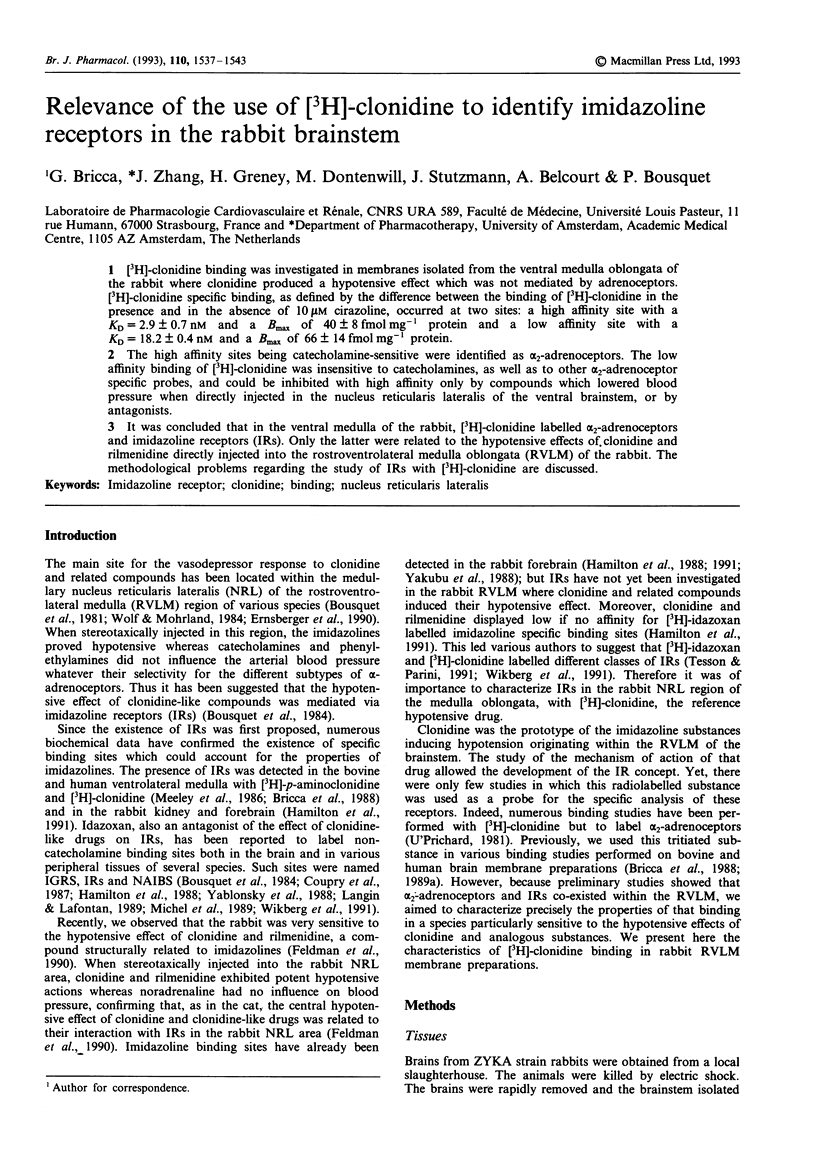
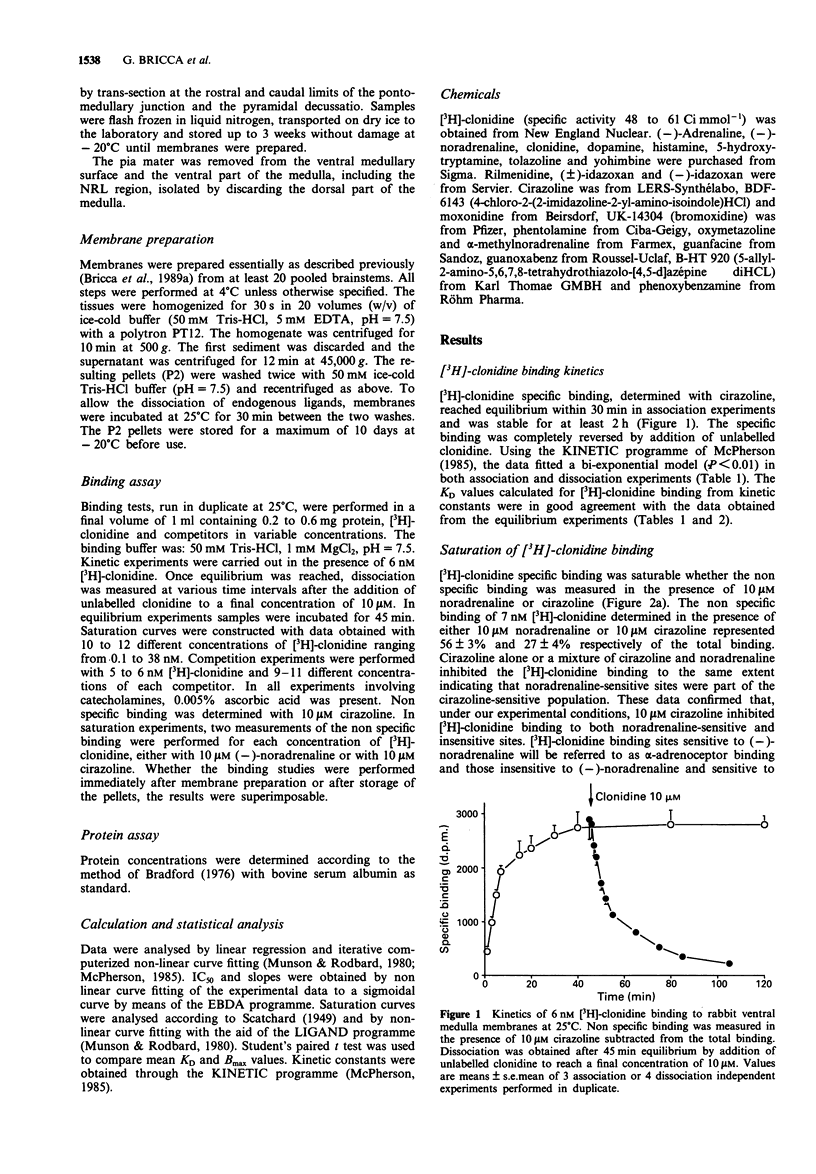
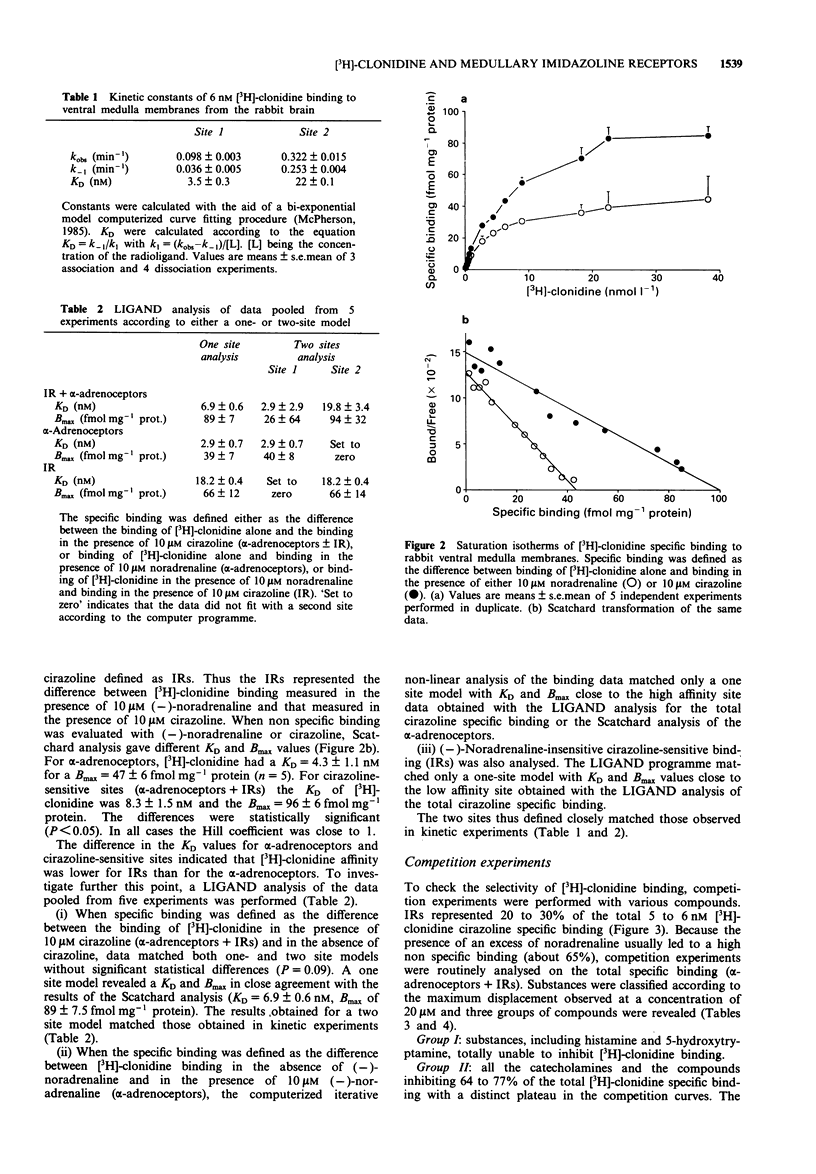
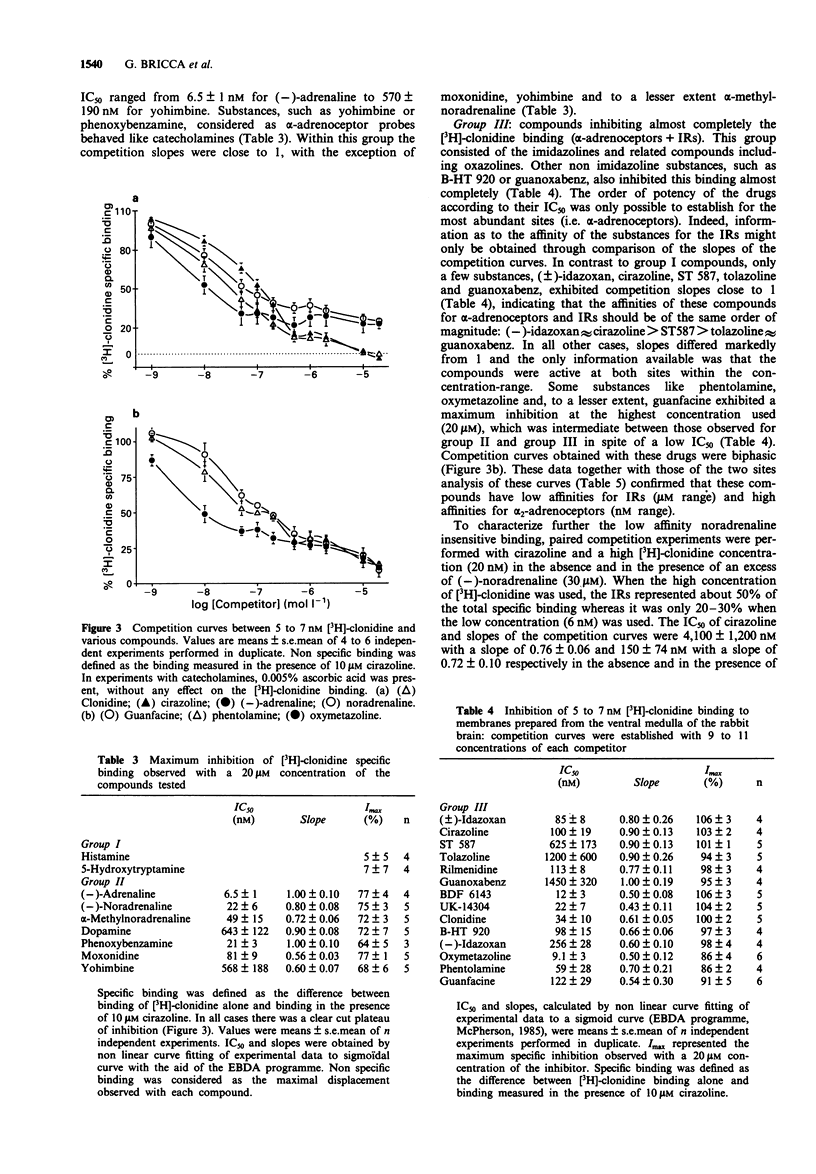
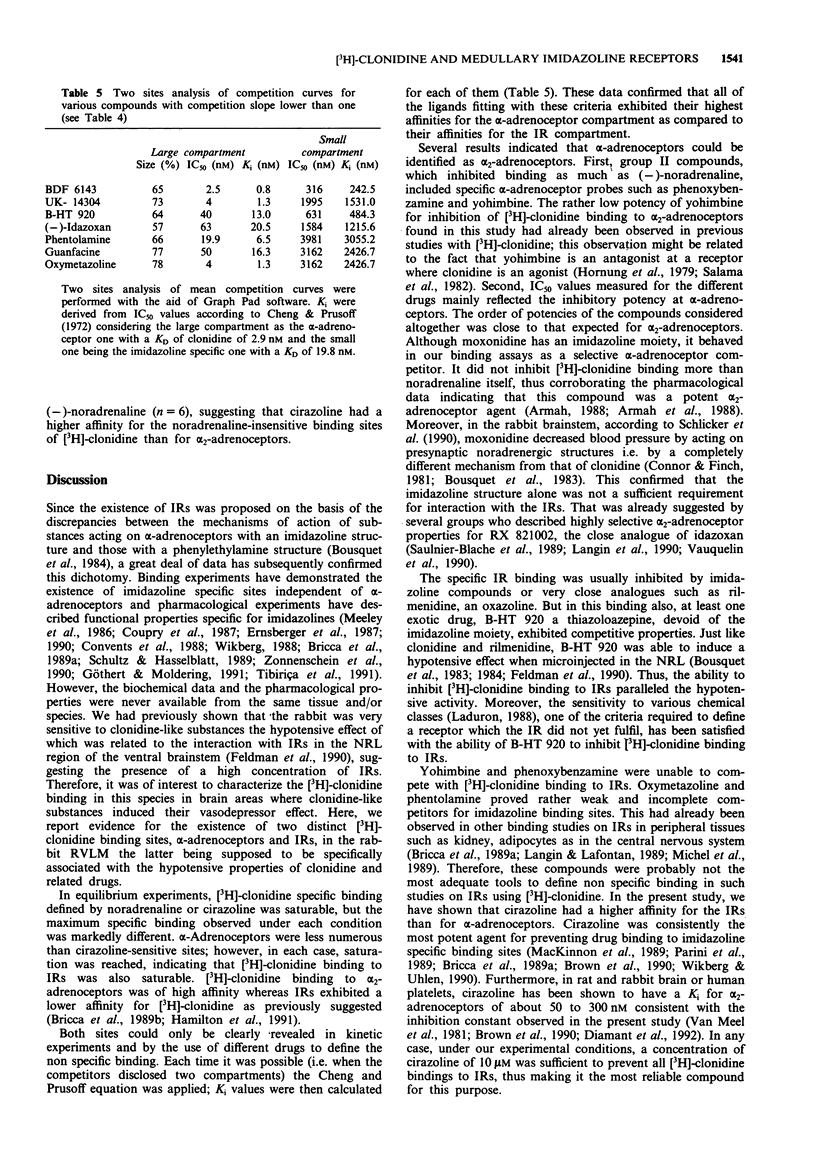
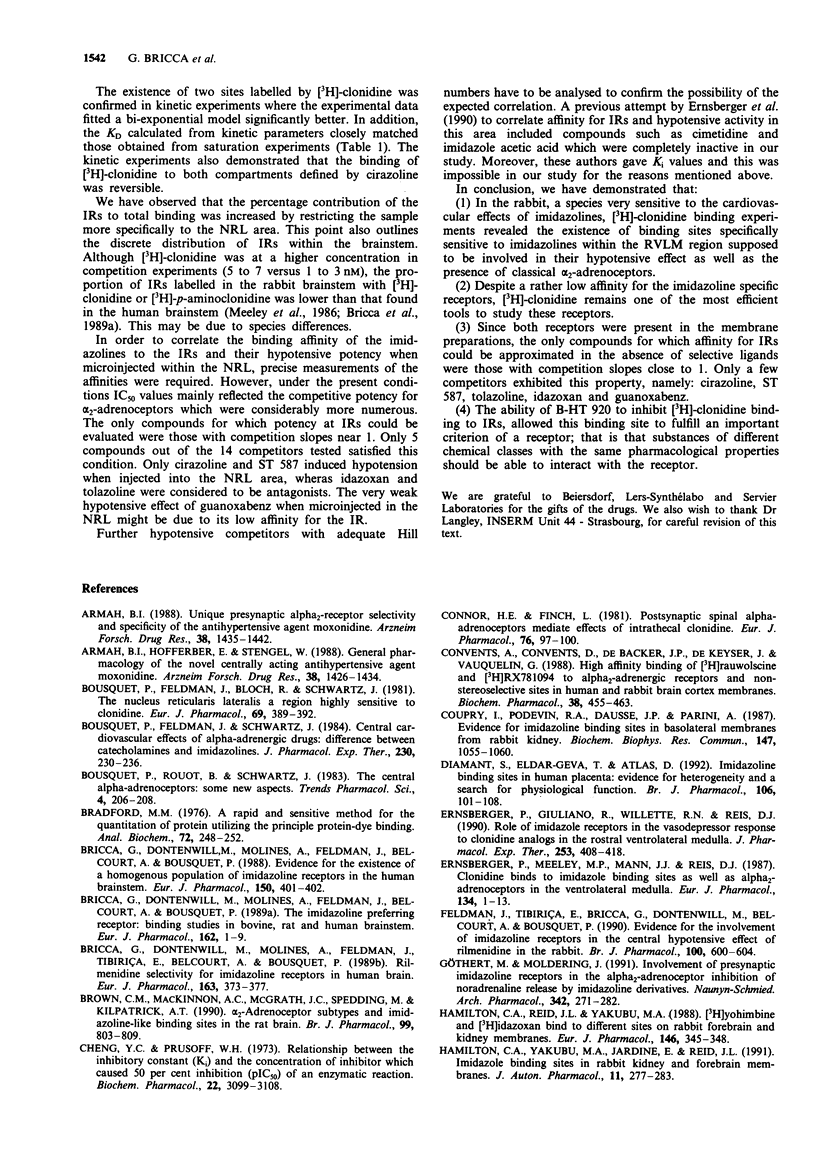
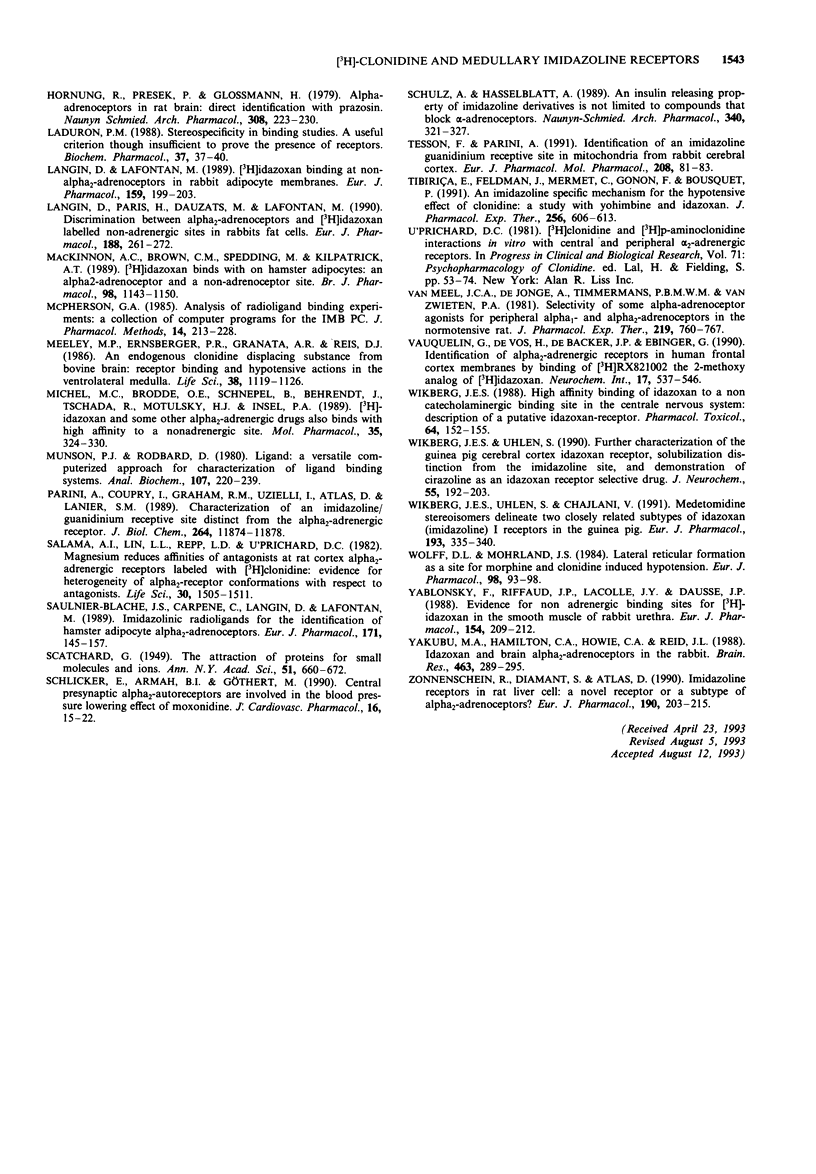
Selected References
These references are in PubMed. This may not be the complete list of references from this article.
- Armah B. I., Hofferber E., Stenzel W. General pharmacology of the novel centrally acting antihypertensive agent moxonidine. Arzneimittelforschung. 1988 Oct;38(10):1426–1434. [PubMed] [Google Scholar]
- Armah B. I. Unique presynaptic alpha 2-receptor selectivity and specificity of the antihypertensive agent moxonidine. Arzneimittelforschung. 1988 Oct;38(10):1435–1442. [PubMed] [Google Scholar]
- Bousquet P., Feldman J., Bloch R., Schwartz J. The nucleus reticularis lateralis: a region highly sensitive to clonidine. Eur J Pharmacol. 1981 Jan 29;69(3):389–392. doi: 10.1016/0014-2999(81)90490-8. [DOI] [PubMed] [Google Scholar]
- Bousquet P., Feldman J., Schwartz J. Central cardiovascular effects of alpha adrenergic drugs: differences between catecholamines and imidazolines. J Pharmacol Exp Ther. 1984 Jul;230(1):232–236. [PubMed] [Google Scholar]
- Bradford M. M. A rapid and sensitive method for the quantitation of microgram quantities of protein utilizing the principle of protein-dye binding. Anal Biochem. 1976 May 7;72:248–254. doi: 10.1016/0003-2697(76)90527-3. [DOI] [PubMed] [Google Scholar]
- Bricca G., Dontenwill M., Molines A., Feldman J., Belcourt A., Bousquet P. Evidence for the existence of a homogeneous population of imidazoline receptors in the human brainstem. Eur J Pharmacol. 1988 Jun 10;150(3):401–402. doi: 10.1016/0014-2999(88)90028-3. [DOI] [PubMed] [Google Scholar]
- Bricca G., Dontenwill M., Molines A., Feldman J., Belcourt A., Bousquet P. The imidazoline preferring receptor: binding studies in bovine, rat and human brainstem. Eur J Pharmacol. 1989 Mar 14;162(1):1–9. doi: 10.1016/0014-2999(89)90597-9. [DOI] [PubMed] [Google Scholar]
- Bricca G., Dontenwill M., Molines A., Feldman J., Tibirica E., Belcourt A., Bousquet P. Rilmenidine selectivity for imidazoline receptors in human brain. Eur J Pharmacol. 1989 Apr 25;163(2-3):373–377. doi: 10.1016/0014-2999(89)90210-0. [DOI] [PubMed] [Google Scholar]
- Brown C. M., MacKinnon A. C., McGrath J. C., Spedding M., Kilpatrick A. T. Alpha 2-adrenoceptor subtypes and imidazoline-like binding sites in the rat brain. Br J Pharmacol. 1990 Apr;99(4):803–809. doi: 10.1111/j.1476-5381.1990.tb13010.x. [DOI] [PMC free article] [PubMed] [Google Scholar]
- Cheng Y., Prusoff W. H. Relationship between the inhibition constant (K1) and the concentration of inhibitor which causes 50 per cent inhibition (I50) of an enzymatic reaction. Biochem Pharmacol. 1973 Dec 1;22(23):3099–3108. doi: 10.1016/0006-2952(73)90196-2. [DOI] [PubMed] [Google Scholar]
- Connor H. E., Finch L. Postsynaptic spinal alpha-adrenoceptors mediate effects of intrathecal clonidine. Eur J Pharmacol. 1981 Nov 19;76(1):97–100. doi: 10.1016/0014-2999(81)90015-7. [DOI] [PubMed] [Google Scholar]
- Convents A., Convents D., De Backer J. P., De Keyser J., Vauquelin G. High affinity binding of 3H rauwolscine and 3H RX781094 to alpha 2 adrenergic receptors and non-stereoselective sites in human and rabbit brain cortex membranes. Biochem Pharmacol. 1989 Feb 1;38(3):455–463. doi: 10.1016/0006-2952(89)90385-7. [DOI] [PubMed] [Google Scholar]
- Coupry I., Podevin R. A., Dausse J. P., Parini A. Evidence for imidazoline binding sites in basolateral membranes from rabbit kidney. Biochem Biophys Res Commun. 1987 Sep 30;147(3):1055–1060. doi: 10.1016/s0006-291x(87)80177-8. [DOI] [PubMed] [Google Scholar]
- Diamant S., Eldar-Geva T., Atlas D. Imidazoline binding sites in human placenta: evidence for heterogeneity and a search for physiological function. Br J Pharmacol. 1992 May;106(1):101–108. doi: 10.1111/j.1476-5381.1992.tb14300.x. [DOI] [PMC free article] [PubMed] [Google Scholar]
- Ernsberger P., Giuliano R., Willette R. N., Reis D. J. Role of imidazole receptors in the vasodepressor response to clonidine analogs in the rostral ventrolateral medulla. J Pharmacol Exp Ther. 1990 Apr;253(1):408–418. [PubMed] [Google Scholar]
- Ernsberger P., Meeley M. P., Mann J. J., Reis D. J. Clonidine binds to imidazole binding sites as well as alpha 2-adrenoceptors in the ventrolateral medulla. Eur J Pharmacol. 1987 Jan 28;134(1):1–13. doi: 10.1016/0014-2999(87)90125-7. [DOI] [PubMed] [Google Scholar]
- Feldman J., Tibiriça E., Bricca G., Dontenwill M., Belcourt A., Bousquet P. Evidence for the involvement of imidazoline receptors in the central hypotensive effect of rilmenidine in the rabbit. Br J Pharmacol. 1990 Jul;100(3):600–604. doi: 10.1111/j.1476-5381.1990.tb15853.x. [DOI] [PMC free article] [PubMed] [Google Scholar]
- Göthert M., Molderings G. J. Involvement of presynaptic imidazoline receptors in the alpha 2-adrenoceptor-independent inhibition of noradrenaline release by imidazoline derivatives. Naunyn Schmiedebergs Arch Pharmacol. 1991 Mar;343(3):271–282. doi: 10.1007/BF00251126. [DOI] [PubMed] [Google Scholar]
- Hamilton C. A., Reid J. L., Yakubu M. A. [3H]yohimbine and [3H]idazoxan bind to different sites on rabbit forebrain and kidney membranes. Eur J Pharmacol. 1988 Feb 9;146(2-3):345–348. doi: 10.1016/0014-2999(88)90314-7. [DOI] [PubMed] [Google Scholar]
- Hamilton C. A., Yakubu M. A., Jardine E., Reid J. L. Imidazole binding sites in rabbit kidney and forebrain membranes. J Auton Pharmacol. 1991 Aug;11(4):277–283. doi: 10.1111/j.1474-8673.1991.tb00325.x. [DOI] [PubMed] [Google Scholar]
- Hornung R., Presek P., Glossmann H. Alpha adrenoceptors in rat brain: direct identification with prazosin. Naunyn Schmiedebergs Arch Pharmacol. 1979 Sep;308(3):223–230. doi: 10.1007/BF00501386. [DOI] [PubMed] [Google Scholar]
- Laduron P. M. Stereospecificity in binding studies. A useful criterion though insufficient to prove the presence of receptors. Biochem Pharmacol. 1988 Jan 1;37(1):37–40. doi: 10.1016/0006-2952(88)90752-6. [DOI] [PubMed] [Google Scholar]
- Langin D., Lafontan M. [3H]idazoxan binding at non-alpha 2-adrenoceptors in rabbit adipocyte membranes. Eur J Pharmacol. 1989 Jan 10;159(2):199–203. doi: 10.1016/0014-2999(89)90707-3. [DOI] [PubMed] [Google Scholar]
- Langin D., Paris H., Dauzats M., Lafontan M. Discrimination between alpha 2-adrenoceptors and [3H]idazoxan-labelled non-adrenergic sites in rabbit white fat cells. Eur J Pharmacol. 1990 Apr 25;188(4-5):261–272. doi: 10.1016/0922-4106(90)90010-u. [DOI] [PubMed] [Google Scholar]
- MacKinnon A. C., Brown C. M., Spedding M., Kilpatrick A. T. [3H]-idazoxan binds with high affinity to two sites on hamster adipocytes: an alpha 2-adrenoceptor and a non-adrenoceptor site. Br J Pharmacol. 1989 Dec;98(4):1143–1150. doi: 10.1111/j.1476-5381.1989.tb12658.x. [DOI] [PMC free article] [PubMed] [Google Scholar]
- McPherson G. A. Analysis of radioligand binding experiments. A collection of computer programs for the IBM PC. J Pharmacol Methods. 1985 Nov;14(3):213–228. doi: 10.1016/0160-5402(85)90034-8. [DOI] [PubMed] [Google Scholar]
- Meeley M. P., Ernsberger P. R., Granata A. R., Reis D. J. An endogenous clonidine-displacing substance from bovine brain: receptor binding and hypotensive actions in the ventrolateral medulla. Life Sci. 1986 Mar 24;38(12):1119–1126. doi: 10.1016/0024-3205(86)90248-1. [DOI] [PubMed] [Google Scholar]
- Michel M. C., Brodde O. E., Schnepel B., Behrendt J., Tschada R., Motulsky H. J., Insel P. A. [3H]idazoxan and some other alpha 2-adrenergic drugs also bind with high affinity to a nonadrenergic site. Mol Pharmacol. 1989 Mar;35(3):324–330. [PubMed] [Google Scholar]
- Munson P. J., Rodbard D. Ligand: a versatile computerized approach for characterization of ligand-binding systems. Anal Biochem. 1980 Sep 1;107(1):220–239. doi: 10.1016/0003-2697(80)90515-1. [DOI] [PubMed] [Google Scholar]
- Parini A., Coupry I., Graham R. M., Uzielli I., Atlas D., Lanier S. M. Characterization of an imidazoline/guanidinium receptive site distinct from the alpha 2-adrenergic receptor. J Biol Chem. 1989 Jul 15;264(20):11874–11878. [PubMed] [Google Scholar]
- Saulnier-Blache J. S., Carpéné C., Langin D., Lafontan M. Imidazolinic radioligands for the identification of hamster adipocyte alpha 2-adrenoceptors. Eur J Pharmacol. 1989 Nov 21;171(2-3):145–157. doi: 10.1016/0014-2999(89)90103-9. [DOI] [PubMed] [Google Scholar]
- Schlicker E., Armah B. I., Göthert M. Central presynaptic alpha 2-autoreceptors are involved in the blood pressure-lowering effect of moxonidine. J Cardiovasc Pharmacol. 1990 Jul;16(1):15–22. doi: 10.1097/00005344-199007000-00003. [DOI] [PubMed] [Google Scholar]
- Schulz A., Hasselblatt A. An insulin-releasing property of imidazoline derivatives is not limited to compounds that block alpha-adrenoceptors. Naunyn Schmiedebergs Arch Pharmacol. 1989 Sep;340(3):321–327. doi: 10.1007/BF00168517. [DOI] [PubMed] [Google Scholar]
- Tesson F., Parini A. Identification of an imidazoline-guanidinium receptive site in mitochondria from rabbit cerebral cortex. Eur J Pharmacol. 1991 Sep 12;208(1):81–83. doi: 10.1016/0922-4106(91)90055-m. [DOI] [PubMed] [Google Scholar]
- Tibiriça E., Feldman J., Mermet C., Gonon F., Bousquet P. An imidazoline-specific mechanism for the hypotensive effect of clonidine: a study with yohimbine and idazoxan. J Pharmacol Exp Ther. 1991 Feb;256(2):606–613. [PubMed] [Google Scholar]
- U'Prichard D. C. 3H-clonidine and 3H-p-aminoclonidine interactions in vitro with central and peripheral alpha 2-adrenergic receptors. Prog Clin Biol Res. 1981;71:53–74. [PubMed] [Google Scholar]
- Wikberg J. E. High affinity binding of idazoxan to a non-catecholaminergic binding site in the central nervous system: description of a putative idazoxan-receptor. Pharmacol Toxicol. 1989 Jan;64(1):152–155. doi: 10.1111/j.1600-0773.1989.tb00620.x. [DOI] [PubMed] [Google Scholar]
- Wikberg J. E., Uhlén S., Chhajlani V. Medetomidine stereoisomers delineate two closely related subtypes of idazoxan (imidazoline) I-receptors in the guinea pig. Eur J Pharmacol. 1991 Feb 14;193(3):335–340. doi: 10.1016/0014-2999(91)90148-j. [DOI] [PubMed] [Google Scholar]
- Wikberg J. E., Uhlén S. Further characterization of the guinea pig cerebral cortex idazoxan receptor: solubilization, distinction from the imidazole site, and demonstration of cirazoline as an idazoxan receptor-selective drug. J Neurochem. 1990 Jul;55(1):192–203. doi: 10.1111/j.1471-4159.1990.tb08838.x. [DOI] [PubMed] [Google Scholar]
- Wolf D. L., Mohrland J. S. Lateral reticular formation as a site for morphine- and clonidine-induced hypotension. Eur J Pharmacol. 1984 Feb 10;98(1):93–98. doi: 10.1016/0014-2999(84)90112-2. [DOI] [PubMed] [Google Scholar]
- Yablonsky F., Riffaud J. P., Lacolle J. Y., Dausse J. P. Evidence for non-adrenergic binding sites for [3H]idazoxan in the smooth muscle of rabbit urethra. Eur J Pharmacol. 1988 Sep 13;154(2):209–212. doi: 10.1016/0014-2999(88)90100-8. [DOI] [PubMed] [Google Scholar]
- Yakubu M. A., Hamilton C. A., Howie C. A., Reid J. L. Idazoxan and brain alpha 2-adrenoceptors in the rabbit. Brain Res. 1988 Nov 1;463(2):289–295. doi: 10.1016/0006-8993(88)90402-7. [DOI] [PubMed] [Google Scholar]
- Zonnenchein R., Diamant S., Atlas D. Imidazoline receptors in rat liver cells: a novel receptor or a subtype of alpha 2-adrenoceptors? Eur J Pharmacol. 1990 Nov 6;190(1-2):203–215. doi: 10.1016/0014-2999(90)94127-j. [DOI] [PubMed] [Google Scholar]
- van Meel J. C., de Jonge A., Timmermans P. B., van Zwieten P. A. Selectivity of some alpha adrenoceptor agonists for peripheral alpha-1 and alpha-2 adrenoceptors in the normotensive rat. J Pharmacol Exp Ther. 1981 Dec;219(3):760–767. [PubMed] [Google Scholar]


